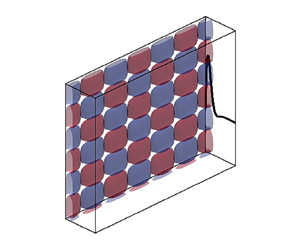Published online by Cambridge University Press: 14 December 2022

The O-type transition caused by a pair of small-amplitude oblique waves in a vertical buoyancy layer of a fluid with Prandtl number  $0.71$ at a Reynolds number of
$0.71$ at a Reynolds number of  $200$ is investigated using linear stability analysis and three-dimensional direct numerical simulation. The small-amplitude oblique waves experience linear growth and undergo nonlinear interactions to generate streamwise vortices/streaks, two-dimensional streamwise waves and harmonic oblique waves. The streamwise vortices/streaks and two-dimensional streamwise waves have twice the spanwise or streamwise wavenumber of the original perturbation, respectively. Unlike the O-type transition in isothermal flat-plate incompressible and compressible boundary layers where streaks dominate the transition, in the vertical buoyancy layer, either streaks or two-dimensional streamwise waves can dominate the flow field during the early stages of oblique transition. The growth rates of streaks and two-dimensional waves are dependent on the wavenumber of the initial oblique waves. Streaks dominate the flow for high streamwise wavenumbers, while two-dimensional streamwise waves dominate the flow for low streamwise wavenumbers. Analysis of the turbulent kinetic energy production and the Reynolds stresses reveals that the early stages of the transition differ depending on the wavenumber of the oblique waves. An increase in the initial amplitude of the oblique waves causes a faster transition from laminar flow; however, the growth rates of the streaks and two-dimensional streamwise waves are independent of the initial amplitude. Even though different modes are dominant during the early stages of the O-type transition, the onset of chaotic flow is caused by the breakdown of streak modes.
$200$ is investigated using linear stability analysis and three-dimensional direct numerical simulation. The small-amplitude oblique waves experience linear growth and undergo nonlinear interactions to generate streamwise vortices/streaks, two-dimensional streamwise waves and harmonic oblique waves. The streamwise vortices/streaks and two-dimensional streamwise waves have twice the spanwise or streamwise wavenumber of the original perturbation, respectively. Unlike the O-type transition in isothermal flat-plate incompressible and compressible boundary layers where streaks dominate the transition, in the vertical buoyancy layer, either streaks or two-dimensional streamwise waves can dominate the flow field during the early stages of oblique transition. The growth rates of streaks and two-dimensional waves are dependent on the wavenumber of the initial oblique waves. Streaks dominate the flow for high streamwise wavenumbers, while two-dimensional streamwise waves dominate the flow for low streamwise wavenumbers. Analysis of the turbulent kinetic energy production and the Reynolds stresses reveals that the early stages of the transition differ depending on the wavenumber of the oblique waves. An increase in the initial amplitude of the oblique waves causes a faster transition from laminar flow; however, the growth rates of the streaks and two-dimensional streamwise waves are independent of the initial amplitude. Even though different modes are dominant during the early stages of the O-type transition, the onset of chaotic flow is caused by the breakdown of streak modes.